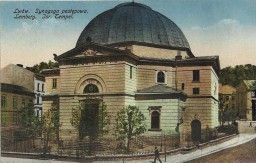<< Previous | Displaying results 6671-6680 of 6720 for "" | Next >>
-
Return to Europe of the St. Louis
ArticleIn May 1939, the St. Louis set sail from Germany to Cuba. Most of the passengers, fleeing Nazi Germany, were denied entry. Learn more about their fates.
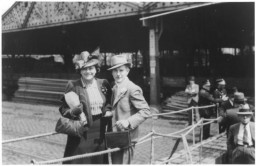
-
Instructors of the Hanoar Hatzioni Zionist youth movement at a summer camp in Lwów, Poland, 1936
PhotoThis group portrait shows instructors of the Hanoar Hatzioni Zionist youth movement at a summer camp in Lwów in 1936. The uniforms the young men wear, combined with the summer camp setting, bear similarities to the wider European scouting movement. Between World War I and World War II, scouting was very popular in Poland among young people. Scouting had a strongly national character. It inspired youth movements for Jews, who were excluded from scouting or who wanted to express their own national…

-
An older Jewish man sits on the Adonis fountain on the main square in Lwów, Poland, circa 1938
PhotoThis photograph shows a market scene at the main square in Lwów, Poland, shortly before the outbreak of World War II. Sitting on the fountain is a man holding a chicken and a basket, likely filled with groceries. His long beard and style of dress, including the overcoat and fedora, identify him as a more traditional, religious Jew. Traditionally, observant Jewish men wore beards and kept their heads covered. An elderly woman selling produce sits on the pavement near the man. In contrast to the man, the…

-
Prewar photograph of Lucie Lind shopping in Lwów, Poland
PhotoLucie Lind shopping in an open-air market in Lwów, Poland, sometime in the 1930s. Lucie was born into an affluent Jewish family on January 23, 1909. At the time, Lwów (Lemberg) was part of the Austro-Hungarian Empire. Lucie was educated in Vienna. Before World War II, she was a housewife. Her first husband was a well-known artist throughout Europe. The couple’s daughter was born in 1936. Lucie’s fashionable clothes, hat, and gloves are typical for middle or upper class women living in Poland at the…
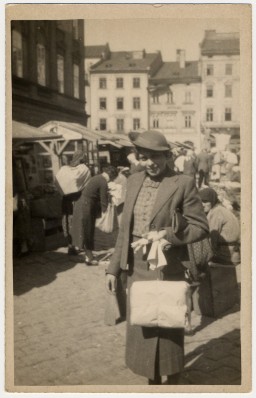
-
Portrait of the Menaker family in Lwów, Poland, circa 1922
PhotoThis portrait from around 1922 depicts three generations of the Menaker family. The hairstyles and clothing highlight the process of acculturation–adapting to and even adopting elements of the dominant, non-Jewish culture–in one Jewish family in the Lwów region. The older female relative wears a wig and a dress with long sleeves and a high collar. Orthodox Jewish women traditionally wore modest clothing and covered their hair with wigs or kerchiefs. By contrast, Szprinca (center) wears a dress with…
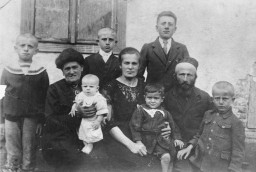
-
Portrait of the Shiber family in Lwów, Poland, 1935
PhotoThis 1935 portrait shows Samuel and Adela Shiber with three of their children—Salomon (left), Matylda (center), and Emanuel (right). The Shibers were a Jewish family from Lwów. Samuel owned a textile workshop in the city. Samuel and Adela spoke Yiddish at home, while the children spoke Polish among themselves. In this photo, there are no obvious markers of Jewish identity. The family wears clothing typical for middle or upper class families at the time. The children are dressed like most schoolchildren…
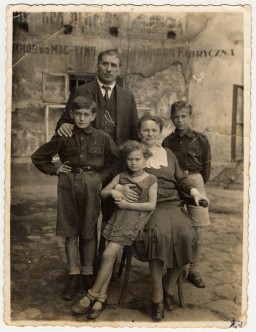
-
Pupils at a public school on Zamarstynowska Street in Lwów, Poland, circa 1930
PhotoStudents sit at their desks in a classroom at a Polish-language public elementary school in Lwów around 1930. In interwar Poland, Jewish children could attend public or private schools. The curriculum in these schools was based on a secular education, in contrast to the traditional heder where boys were schooled in Jewish texts and traditions. This particular school was located in the city’s predominantly Jewish neighborhood and almost all of the students were Jewish. Before attending this school,…
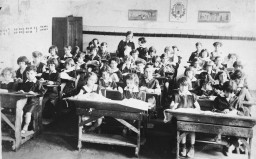
-
Daniel and Laura Schwarzwald sit on a beach in Zaleszczyki, Poland, 1935
PhotoThis prewar photo shows newly married Daniel and Laura (née Litwak) Schwarzwald enjoying a day on the beach in Zaleszczyki, Poland (today Zalishchyky, Ukraine). The Schwarzwalds were Jews from Lwów. They married in 1935 and lived in a fashionable Lwów district where Jews were a minority. Both Laura and Daniel pursued university educations and spoke Polish, Russian, German, and Yiddish. Daniel also spoke English. At the time of their marriage, Daniel was a successful businessman. He owned a lumber…
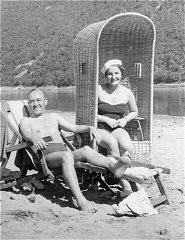
-
The Diverse Jewish Community of Interwar Lwów, Poland (now Lviv, Ukraine)
Media EssayBetween World War I and World War II, the multiethnic city of Lwów was in eastern Poland and home to one of the country’s largest Jewish communities. Jews made up about one-third of Lwów’s population, numbering around 100,000 people on the eve of World War II. The diversity of Lwów’s Jews was reflected in many aspects of their everyday lives. Most Jews in Lwów were multilingual and communicated in different languages, depending on the context. For example, many people spoke Yiddish at home,…
-
Postcard portraying the Progressive Synagogue in Lwów, Poland, circa 1917
DocumentBetween World War I and World War II, dozens of synagogues and prayer houses served the religious needs of Lwów’s diverse Jewish community. This postcard from around 1917 shows the Progressive Synagogue, also known as the Temple, in Lwów. Built in the 1840s and originally named the German-Israelite Prayer House, it served the city’s progressive Jewish community. From 1904, the synagogue’s rabbi regularly preached in Polish. The Nazis destroyed the synagogue in 1941.
